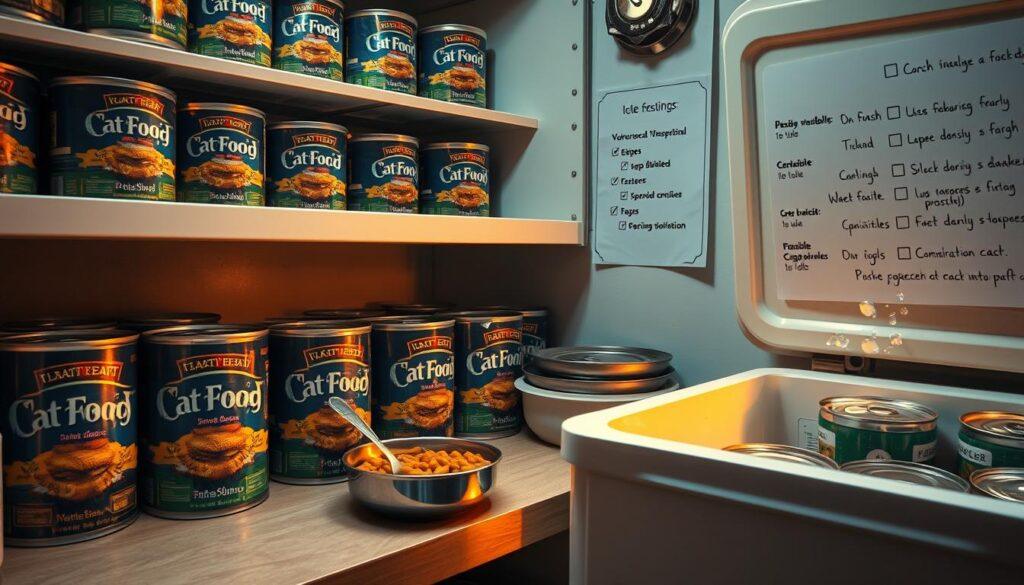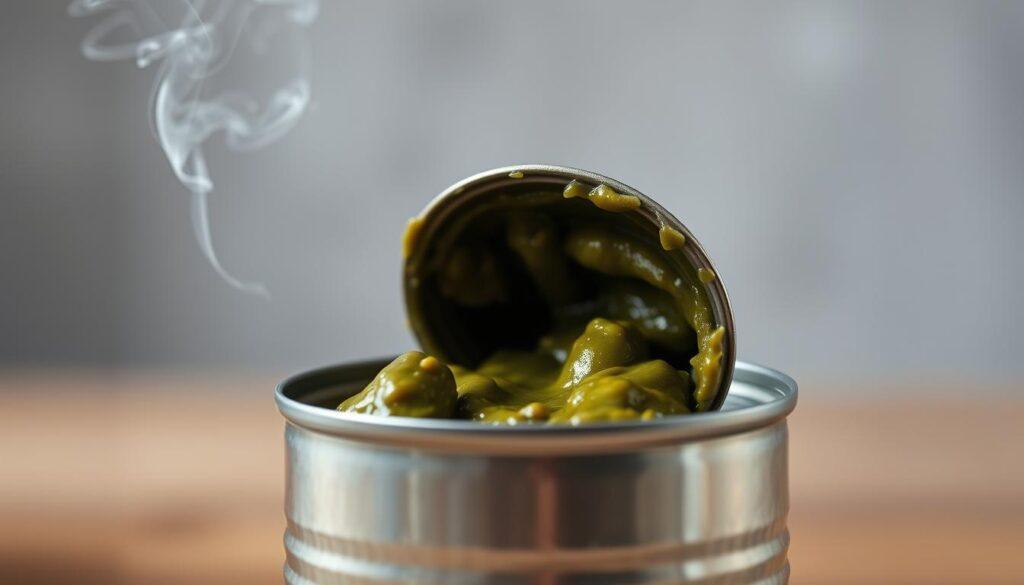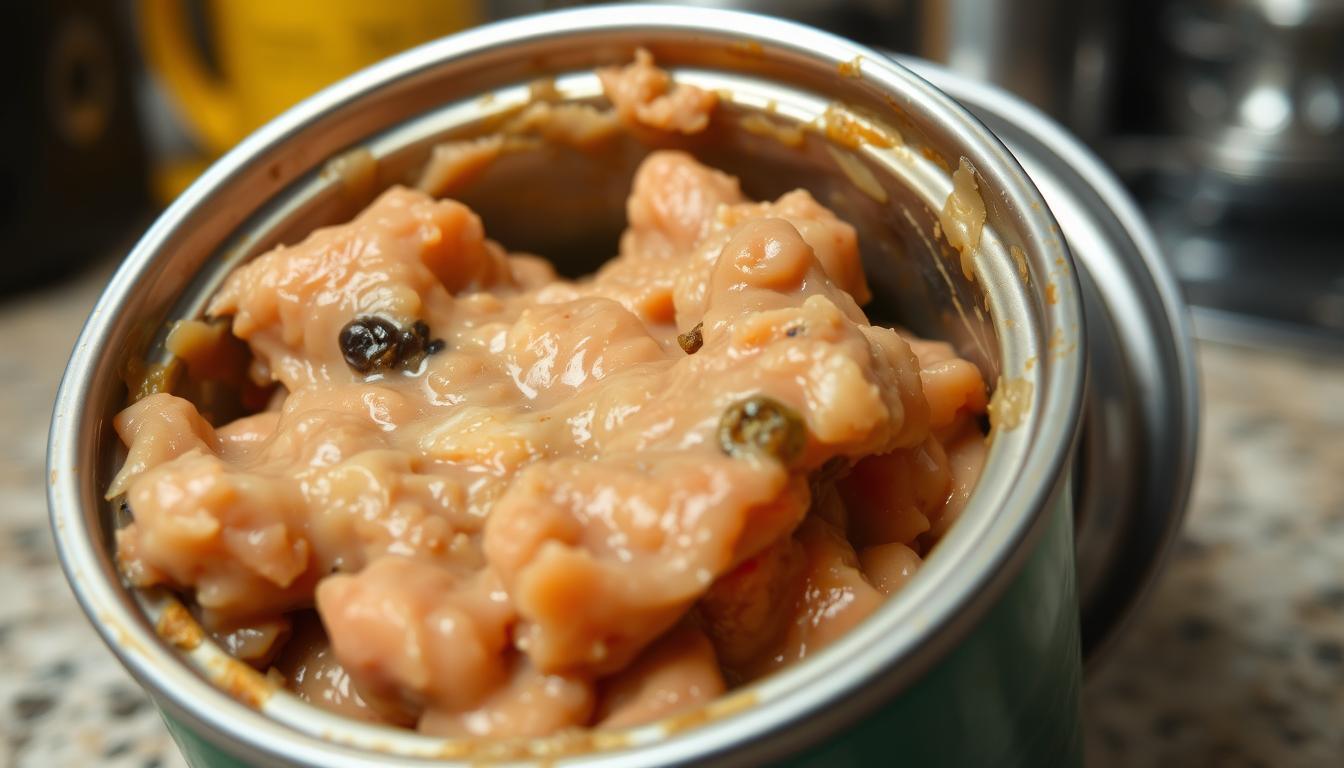Did you know that about 25% of cat owners have fed their cats spoiled wet food1? This can cause serious health problems like food poisoning and stomach issues. It’s important for pet owners to know how to spot bad wet cat food to keep their cats safe and healthy.
Wet cat food spoils faster than dry food because it’s so wet2. Food makers follow strict rules to make safe food, but bad storage or handling can spoil it1. Knowing how to spot bad wet cat food can help prevent your cat from eating something harmful1.
We’ll talk about the dangers of bad wet cat food, how to store and handle canned food right, and how to tell if it’s gone bad. By being informed and careful, you can make sure your cat eats safe, healthy food. This avoids the health risks of spoiled cat food.
Key Takeaways
- Spoiled wet cat food can be detected through visual inspection, smell, and texture changes1.
- Mold growth and unusual colors indicate contamination and should not be fed to cats12.
- Cats may instinctively reject spoiled food based on taste or smell12.
- Proper storage in airtight containers and refrigeration can extend the shelf life of wet cat food2.
- If a cat ingests spoiled food, prompt veterinary care is essential to prevent serious health complications1.
Understanding the Shelf Life of Wet Cat Food
Knowing how long wet cat food lasts is key to your cat’s health. Storing and handling it right keeps it fresh and full of nutrients. This helps avoid bad food and keeps your cat safe.

Factors Affecting the Shelf Life of Wet Cat Food
Many things affect how long wet cat food stays good. These include how it’s made, where it’s stored, and if it has preservatives. Most cans have an expiration or “best by” date3.
High heat and moisture can make food go bad faster. This is especially true for wet cat food left out of the fridge4.
The canning method seals the food in airtight cans. It kills harmful germs like Salmonella or E. coli. This makes the food safe to eat for a longer time.
Proper Storage Guidelines for Wet Cat Food
Keeping wet cat food fresh and safe is important. Experts say not to leave foods like pet food, dairy, and eggs out for more than four hours4. Bacteria like Salmonella and E. coli can grow quickly after four hours4.
Here are some tips for storing cat food:
- Keep canned food in a cool, dry spot away from heat and sunlight3.
- Use airtight containers in the fridge for leftovers.
- Throw away leftovers after 5 days.
- Use clean tools when handling food.
- Seal leftovers well and check expiration dates to keep your cat healthy4.
| Storage Location | Temperature Range | Maximum Storage Time |
|---|---|---|
| Pantry | 50-70°F (10-21°C) | Unopened: Until expiration date |
| Refrigerator | 35-40°F (1.6-4.4°C) | Opened: 5-7 days |
By following these cat food storage guidelines, you can keep your cat safe and healthy. Remember, the right storage and handling are key to keeping canned cat food fresh3.
Signs of Spoilage in Wet Cat Food
As a cat owner, knowing when your cat’s wet food has spoiled is key. The expiration date helps, but storage and packaging matter too. Spotting spoilage signs ensures your cat eats only fresh, safe food. Understanding your cat’s appetite changes and knowing when to discard bad food is vital for their health.
Unusual Odors
An unpleasant smell is a clear sign of spoiled wet cat food. Fresh food should smell mild and meaty. A strong, sour, or rancid smell means it’s bad and should not be given to your cat. Experts say not to leave potentially hazardous foods out for more than four hours to prevent bacterial growth and contamination5. Trust your nose and be cautious with any bad smells.
Visual Changes in Appearance
Checking your cat’s wet food visually can also tell if it’s safe. Look for any discoloration, like darkening or graying of the meat, or mold growth. Spoiled food may also change color or texture, becoming slimy or too dry5. If you see these changes, throw the food away to protect your cat’s health.

Texture Alterations
Spoiled wet cat food may also have a different texture. Fresh food should have a consistent texture with visible meat or fish chunks. If it’s watery, grainy, or has an odd consistency, it might be spoiled. Texture changes can also mean harmful bacteria like Salmonella or E. coli are present, especially if food has been left out for more than four hours5.
Knowing these spoilage signs helps protect your cat’s health and ensures they get the best nutrition. Regularly check your cat’s wet food before and after opening to catch any issues early. If you think the food has spoiled, throw it away and replace it with a fresh, high-quality option like PrettyPlease wet cat food5. Being vigilant and proactive about your cat’s food safety is crucial for being a responsible and caring pet owner.
Risks of Feeding Spoiled Wet Cat Food
As a cat owner, knowing the dangers of spoiled wet cat food is key. Many cat owners give their pets canned food, but it’s risky to leave it out too long6. Experts say not to leave food out for more than four hours to avoid bacteria growth6. Bacteria in wet cat food can double in just 20-30 minutes, making it dangerous fast7.
Left-out wet cat food can quickly become a health risk for cats8. High temperatures and humidity speed up spoilage, making it unsafe for cats to eat6. Even room temperatures above 50°F can spoil wet cat food in 2 hours, causing bacteria to grow quickly7.
Food Poisoning and Gastrointestinal Issues
Feeding spoiled wet cat food can cause food poisoning and stomach problems. It may contain harmful bacteria like Clostridia, leading to botulism, a serious condition. Other issues include digestive upset, vomiting, and diarrhea.
Cats can get bacterial infections from spoiled food, showing symptoms like vomiting, diarrhea, loss of appetite, and fever7. Young, senior, or weak cats are more at risk because of their health7.
Potential Health Hazards for Cats
Feeding spoiled wet cat food can also harm your cat’s health in the long run. It can weaken their immune system, making them more likely to get sick.
| Signs of Spoiled Wet Cat Food | Potential Health Hazards |
|---|---|
| Off-putting smell, color changes, and visible mold growth6 | Food poisoning and gastrointestinal issues |
| Unusual texture or consistency | Weakened immune system |
| Cat’s refusal to eat the food | Chronic health problems |
To avoid the dangers of spoiled wet cat food, follow storage tips and watch for signs of spoilage. Wet cat food should not sit out for more than one to two hours to stop bacteria growth8. Leftover wet cat food can last 3-5 days in the fridge if stored properly7.
It’s important for cat owners to follow food safety rules6. Knowing how to tell if wet cat food is bad and taking the right steps can keep your cat healthy.
Checking the Expiration Date
Checking the expiration date is a simple way to see if your cat’s wet food is still good. Most cat food has an expiration or “best by” date on the package9. But, it’s important to know that pet foods in the U.S. don’t always have these dates10.
When buying canned cat food, make sure it has a recent expiration date. Never give your cat expired food9. The shelf life of pet food varies by brand and type. Canned food usually lasts a year from when it was made10.
Even though packaging helps prevent contamination, some foods are more at risk10. Look at the food’s appearance, smell, and texture to check if it’s spoiled9. Also, watch how your cat reacts to the food. If they don’t want to eat it, it might be bad9.
Preservatives in pet food can weaken over time, making it more likely to spoil10. Stores usually throw away expired products, but there’s no law against selling them10. Unlike canned and dry foods, fresh items have a real expiration date10.
Keeping canned cat food fresh is key. Always check the expiration date and watch for signs of spoilage before feeding it to your cat9. If the date has passed or the food looks or smells off, throw it away. This is to keep your cat safe from health risks.
| Indicator | Fresh Wet Cat Food | Spoiled Wet Cat Food |
|---|---|---|
| Expiration Date | Within the “best by” date | Past the expiration date |
| Smell | Normal, appealing aroma | Unusual, off-putting odor |
| Appearance | Consistent color and texture | Discoloration or mold growth |
| Cat’s Reaction | Eagerly consumes the food | Refuses to eat or shows disinterest |
Proper Storage Techniques for Wet Cat Food
Keeping wet cat food fresh is key to your cat’s health. Once opened, it should be refrigerated and eaten within a few days to avoid spoilage11. To keep your cat’s food safe and healthy, follow these tips for refrigeration, using airtight containers, and avoiding temperature changes.
Refrigeration Guidelines
Move any leftover wet cat food to an airtight container after opening. It can stay good in the fridge for 3-5 days12. Don’t let wet cat food sit out for more than 4 hours to stop bacteria from growing12. The FDA says to throw away cat food that’s been at room temperature (90°F or 32°C) for over 2 hours for safety12.
Airtight Containers and Resealing
Using airtight containers or automatic pet feeders can extend your cat’s food shelf life. Glass containers are better than plastic because they don’t absorb odors or fats11. Sealing food in these containers keeps it fresh by blocking air, heat, humidity, pests, and oxidation12. An automatic feeder like the Petlibro can hold up to 6 liters or 10 pounds of food, keeping it safe for up to 6 days12.
Avoiding Temperature Fluctuations
Following cat food storage guidelines is vital for your cat’s health11. Keep food containers in a cool, dry spot away from sunlight and heat. Don’t store food in damp places where temperatures can change a lot. Clean your cat food containers weekly to prevent bacteria11.
| Type of Cat Food | Storage Method | Shelf Life |
|---|---|---|
| Wet Cat Food (Opened) | Refrigerate in airtight container | 3-5 days |
| Dry Cat Food (Opened) | Store in airtight container in cool, dry place | 4-6 weeks |
| Dry Cat Food (Unopened) | Store in original packaging in cool, dry place | 6-12 months from “best by” date |
Signs that stored cat food has gone bad include off odors, discoloration, visible mold, and clumping in dry food11. Feeding your cat spoiled food can lead to stomach problems, food poisoning, and long-term health issues11. By sticking to these guidelines, you can keep your cat’s food fresh, safe, and nutritious.
How to Tell If Wet Cat Food Is Bad
As a cat owner, it’s key to keep your pet’s food safe and fresh. Wet cat food, with its moisture, needs extra care to avoid spoilage. Knowing when wet cat food has gone bad is crucial for your cat’s health.
Unusual Smell or Odor
A bad smell is a clear sign of spoiled cat food. Fresh wet cat food smells mild and meaty. If it smells strong, rancid, or sour, don’t feed it to your cat1.
Discoloration or Mold Growth
Changes in color or mold growth mean the food has spoiled. Green, blue, or white fuzzy patches on the food mean it’s bad and should be thrown away1.
Change in Texture or Consistency
Bad wet cat food can look watery, grainy, or have layers. If it feels sticky, slimy, or has an odd feel, it’s best to throw it away. These signs indicate spoiled food1.
Cat’s Refusal to Eat the Food
Cats know when food is bad by smell and taste. If your cat won’t eat their favorite wet food, it might be spoiled. But, if they always refuse and seem sick, see a vet1.
To avoid giving your cat bad food, follow these tips:
- Always check the expiration date before buying and serving wet cat food1.
- Look for dents, bulges, or leaks in the can or pouch, as these can be unsafe13.
- Keep wet cat food in a cool, dry place and refrigerate leftovers in a sealed container13.
- Check the food’s appearance, smell, and texture before serving it13.
If your cat eats spoiled food and gets sick, call your vet right away. It’s important to see a vet if your cat eats bad food and shows signs of illness1.
“When in doubt, throw it out. It’s always better to discard questionable wet cat food than to risk your cat’s health and well-being.”
Knowing the signs of bad wet cat food and following proper storage and handling can help keep your cat healthy. Learn more about signs of spoiled wet cat food and how to store it safely.
What to Do with Spoiled Wet Cat Food
As a responsible cat owner, keeping your cat healthy is key. This means making sure they eat safe, fresh food. But sometimes, you might think your cat’s wet food has spoiled. Knowing how to handle this situation is important.
Safe Disposal Methods
If you think your cat’s wet food has spoiled, the first thing to do is throw it away safely. Experts say not to leave wet cat food out for more than four hours to stop bacteria from growing14. Bacteria like Salmonella and E. coli can grow a lot after four hours, which can make your pet sick14.
To keep risks low, put the spoiled food in a plastic bag and throw it away in a covered trash can. This stops pests and keeps bacteria from spreading1.
When getting rid of spoiled cat food, remember a few things:
- Use a sealed plastic bag to keep the food in
- Put the bag in a covered trash can to avoid pests
- Don’t throw the food in compost bins or open areas
- Clean and disinfect any surfaces or containers that touched the spoiled food
Contacting the Manufacturer for Guidance
If you’re worried about a cat food batch or see signs of contamination, contact the maker. Cat food makers follow strict rules to make safe products1. They can help you figure out how to get rid of the food and might even offer refunds or new food.
When you call the manufacturer, have some info ready:
| Information | Details |
|---|---|
| Product name and variety | Specify the exact name and flavor of the cat food |
| Lot number and expiration date | Provide the lot number and expiration date printed on the packaging |
| Purchase date and location | Mention when and where you purchased the product |
| Description of the issue | Explain the signs of spoilage or contamination you observed |
Also, watch your cat’s health closely if they might have eaten contaminated cat food. If your cat eats spoiled food, see a vet right away1. If your cat acts differently or shows signs of illness, call your vet fast.
Always be careful with potentially spoiled cat food1. Dispose of it safely, talk to the manufacturer, and watch your cat’s health. This way, you keep your cat safe and happy.
Conclusion
Keeping your cat’s food safe and fresh is key for their health. Knowing how to spot spoiled food and store it right helps a lot. In the US, pet food doesn’t always have an expiration date, but many do for quality15. Always throw away canned or fresh cat food after 4 hours at room temperature to stop bacteria growth15.
If you think your cat’s food is bad, get rid of it and call the maker if needed. Cats can get food allergies, including from wet food16. Signs of an allergy might show up on their head and neck, like itching or redness16. Taking your cat to the vet for tests or advice on a special diet can help with allergies16. Making sure your cat’s diet is safe can prevent health issues and keep them happy.
Learning about food storage, spoilage signs, and allergens is important. Dry kibble should stay cool and be eaten within 6 weeks of opening15. Some cats with wet food allergies do better on a steady diet, while others need variety16. Always talk to your vet to find the best food for your cat and to discuss any nutrition concerns.
FAQ
How long does wet cat food last after opening?
What are the signs that wet cat food has gone bad?
Can I feed my cat wet food past the expiration date?
How should I store wet cat food to maintain freshness?
What health risks are associated with feeding spoiled wet cat food?
What should I do if I suspect my cat’s wet food has gone bad?
Source Links
- Has Your Cat Food Gone Bad? 8 Vet Reviewed Signs to Look For – Catster – https://www.catster.com/nutrition/has-your-cat-food-gone-bad/
- How to Tell If Cat Food Has Gone Bad: Vet-Reviewed Tips | PangoVet – https://pangovet.com/pet-lifestyle/cats/how-to-tell-if-cat-food-has-gone-bad/
- 7 Signs on How to Tell if Canned Cat Food is Spoiled? – https://mywaggle.com/blogs/pet-food/7-signs-on-how-to-tell-if-canned-cat-food-is-spoiled?srsltid=AfmBOopSaWWbcNTf3e0Gk42VBSkAbAaGZLjbjtL2KaQNyLgrEXtNIxih
- How Long Can Wet Cat Food Sit Out? | PrettyLitter – https://www.prettylitter.com/blog/how-long-can-wet-cat-food-sit-out?srsltid=AfmBOoqFZMgK2-X987maEvOFRrHBnowUcminHntEk4aX9dvFua6Ym6Sq
- How Long Can Wet Cat Food Sit Out? | PrettyLitter – https://www.prettylitter.com/blog/how-long-can-wet-cat-food-sit-out?srsltid=AfmBOooyNh7tqg59pl66wmmM2Yj8GziYjcbcLejOrPryKOFFYbzDBRhH
- How Long Can Wet Cat Food Sit Out? | PrettyLitter – https://www.prettylitter.com/blog/how-long-can-wet-cat-food-sit-out?srsltid=AfmBOopaLaukKoZzLHXbHQZQbHVCPoHQA89vFKGMROD7JL5GkW9bimPe
- How Long Can You Leave Wet Cat Food Out? Vet-Verified Health & Safety Info – Catster – https://www.catster.com/cat-health-care/how-long-can-you-leave-wet-cat-food-out/
- How Long Can I Let Wet Cat Food Sit Out? | Wellness Pet Food – https://www.wellnesspetfood.com/blog/how-long-can-i-let-wet-cat-food-sit-out/
- 7 Signs on How to Tell if Canned Cat Food is Spoiled? – https://mywaggle.com/blogs/pet-food/7-signs-on-how-to-tell-if-canned-cat-food-is-spoiled?srsltid=AfmBOoocOZzp2F1TULwahhm7XOXLa78jEWz9RZ2o4cNkQHfNA6Yl456T
- Is Expired Cat Food Safe? – https://www.thesprucepets.com/expired-cat-food-dates-2661772
- Cat Food Storage Mistakes: What You Need to Know in 2025 – https://waterdownonvet.ca/cat-food-storage-mistakes/
- How to Safely Store Cat Food and Maximize Freshness? The 2023 Guide – https://petlibro.com/blogs/all/how-to-safely-store-cat-food
- 7 Signs on How to Tell if Canned Cat Food is Spoiled? – https://mywaggle.com/blogs/pet-food/7-signs-on-how-to-tell-if-canned-cat-food-is-spoiled?srsltid=AfmBOorhpwmRsWJXSOHw7liJK2aYr3kHW-9WQ6E6JLPxRPMZnaDLgie4
- How Long Can Wet Cat Food Sit Out? | PrettyLitter – https://www.prettylitter.com/blog/how-long-can-wet-cat-food-sit-out?srsltid=AfmBOopwG5c7Cp8VRB9c72D3Z5cNZkBM5KtFYT_id6v8Qu8oCxIrP7PF
- 9 Signs That Cat Food Has Gone Bad: Vet-Approved Food Storage Tips | Hepper – https://www.hepper.com/signs-that-cat-food-has-gone-bad/?srsltid=AfmBOorjLwY2OniMOSXT_Vm11DtdJkNMJlhiNEXCfDvZtybn-1-O8PCN
- Shocking Side Effects of Wet Cat Food Every Owner Must Know – https://catotips.com/side-effects-of-wet-cat-food/

